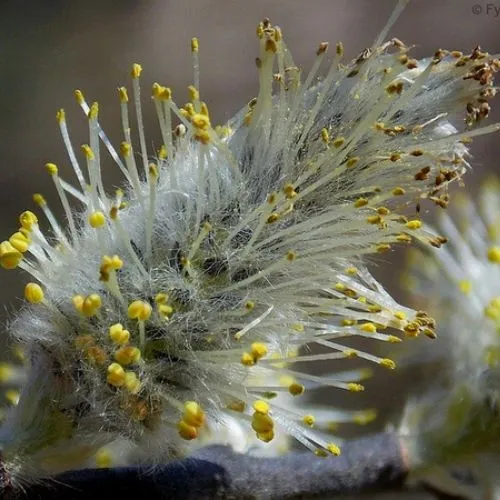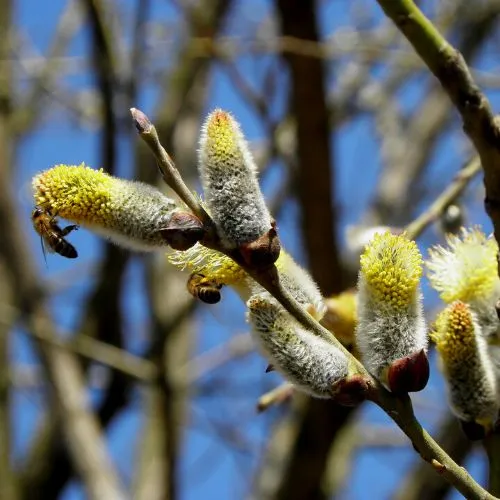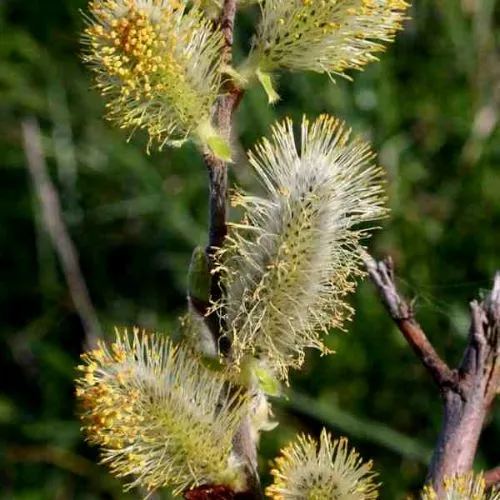The willow tree and its 400+ wonderful species are often seen as a symbol of longevity and survival. Their majestical hanging vine-like branches have been engraved into folklore as far back as ancient Chinese times.
Willows, in general, are very useful in a range of different industries. That’s why everyone should know how to preserve willow branches properly.
The typical use cases for willows are for weaving baskets, assisting in the structural construction, making charcoal for drawing, in the medical field, and for ornamental purposes.
The pussy willow is probably the most recognized of the species. Often used within craft and decoration.

It is a smaller variant known for its slight, furry flowers that can come in various colors, including but not limited to brown, green, white, and pink.
Pruning and preserving willow branches is an important skill to master if you plan to use them for craft purposes.
The willow will only stay in a certain state for a certain period. If untreated, it will become unusable for that specific purpose.
This article will show you the do’s and don’ts when preserving willow branches for various functions. Let’s dive in, shall we?
Table of Contents
Types of Pussy Willow Explained
Pussy willow is a name used for some smaller variants of the willow family. These types have smaller cat-like fur ‘leaves’ that form in the early spring.
There are many species of pussy willow, but only 3 of them are more commonly seen today. These 3 are:
Salix discolor
(American pussy willow, glaucous willow) – This species of pussy willow can be found in Northern America and as far up as Canada and Alaska. They generally grow around forest and wetland areas. They can grow as tall as 20ft (6m). The Salix leaves are 3-14cm long and 1-3.5cm broad.
The leaves are green on top and gray-white on the underside. The catkins (flowers) of this type of willow are soft, silky, and silver in color. They start forming early in spring and signify that new leaves are on their way.

They also contain salicin, used by the native Americans for centuries as a natural painkiller.
Salix caprea

(goat willow, pussy willow, great sallow) – This species of pussy willow can be found in Europe as well as Western and Central Asia.
Much like the Salix discolor, the caprea also thrives in forest and lowland regions, especially around bodies of water such as lake shores, streams, and river banks.
These species of willows can reach heights of 26–33 ft (8–10 m). The leaves can grow up to 3–12cm long and 2–8 cm broad.
The leaves have thin hairs on top and thicker hairs on the underside. The catkins can grow to 3-7cms and are also soft, silky, and silver in color. They start to form early in the spring.
The male catkins mature yellow as they start to release their pollen. The females, on the other hand, turn a palish green as they mature. The Salix caprea’s main uses are painkillers, cut flowers, and willow flutes.
Salix cinerea
(common sallow, grey sallow/willow, grey-leaved sallow, large grey willow, pussy willow, rusty sallow) – The Salix Cinerea is mainly found in Europe but has also been sighted at the North Western edges of Asia. This type of willow grows best snuggled deep within wetlands.
This can include marshland and stream sides, depending on the species. They can grow from 13–50 ft (4–15 meters) tall. Their leaves are arranged in a spiral pattern and grow to around 1-3 ½ inches long (2-9 cm) and 1⁄2–11⁄2 inches broad (1-3 cm).

They are green in color on top and have thin hairs on the underside. The catkins can grow 2-5 cm in length and form in early spring.
The males start silver and turn yellow as they start to pollinate. The females are greenish-gray and don’t change color.
They do, however, form wooly seeds once pollinated by the wind. This species of willow provides a heap of nectar for pollinators and has some medicinal benefits, including pain relief.
How to preserve willow branches (Multiple Methods)
Willow branches can be utilized to produce many useful items, including baskets, weapons, fencing, furniture, sports equipment, etc.
One of the most common uses for the branches is within the craft and decoration industry.
The problem with using it within this scope of production is that it must first be preserved in such a way for it to be usable. A range of methods can be adopted to help preserve them for specific uses.
The most common are as follows.

How to Preserve Willow for Floral Arrangements?
Willow branches are a great material for creating floral arrangements for several reasons. They are strong and flexible; they can match many designs and are generally quite easy to preserve and prepare. Here are some great tips for doing so.
- Choose good quality branches by cutting them later in the winter to early spring. This period will ensure that minimal milky sap is present.
- Clean the branches with a knife to remove any bark and/or leaves.
- Give the branches a good soaking for a minimum of 24 hours. This will help soften them up for extra flexibility.
- Let them dry by laying them out in a well-ventilated room such as a garage or undercover carport.
- When you are satisfied that they are completely dry, they are ready to be arranged.
How to Preserve Willow for Decor?
Like floral arrangements, willow can also be used for various decor-type projects. You would generally see this type of branch in styled homes as a prop in a vase or even hanging.
Using willow is quite a fast-growing craft concept due to its bendability and natural look.
They need to stay dry, though, as they can start to grow roots or mold as a result. Either one will ruin the overall aesthetics of the style. Let’s have a look at preserving the willow branches for decor.
- Using a clean, sharp pair of pruning shears or gardening scissors, gather some willow, to begin with.
- Try to make sure that they are even lengths and thicknesses to improve the look of your project. Again, late winter to early spring is the best time to collect willow as they’ll have less milky sap to deal with.
- Soak your stock in water for at least 24 hours per foot (in length), meaning if you have 3-foot lengths, soak for 3 days. Keep them in a cool, dark area. You want to avoid them rotting and stinking if hot and humid temperatures heat the water. Soaking them helps to improve their flexibility. This will make them easier to work with.
- Remove them from the water after the required time and stand them upright dry. This will ensure that all of the water runs off the branches. The drying process generally takes 2 or so weeks to completely run its course.
- Next, you will need to spray your branches with waterproof sealant. This prevents cracks, keeps any pests from damaging them, and increases their strength. It also makes them waterproof.
- Leave them for a day or so to dry. It’s best to hang dry them in a cool, dry, well-ventilated area. Once satisfied with the finished product, you can use them in your projects. They can be touched up with the spray if you realize that it is wearing away. Simply go through the same procedure again.
How to Preserve Willow Branches for Crafts?
Use the same procedure as you would for preserving willow branches for decor. Only this time, make sure you cut the branches down to smaller sizes before soaking them.
The craft requires custom shapes and sizes, which will be a personal preference. You may want to cut, soak, dry and waterproof bundles of specific lengths and thicknesses for long-term usage.
How to preserve willow branches with glycerin?
Another really easy way to preserve willow branches is by using glycerin. The glycerin is soaked into the branch, which essentially replaces the moisture.
This keeps the branches looking new and fresh instead of dried out like some other methods. The best way to apply glycerin is by:
- Creating a solution. The best ratio is 1:2 (1 part glycerin:2 parts water), Eg: 1 liter glycerin:2 liters water.
- Give it a gentle mix; the solution will start to turn cloudy but thin out and turn clear once completely mixed.
- Add latex paint to the glycerin mix and stir until both are complete;y combined. Make sure the container is large enough to fit both liquid mixes. You can also go one step further and add a food dye to the mixture. Be creative. You can either choose a natural woody color or something more bizarre. Personal preference and creativity are key here.
- Your glycerin/latex solution is now ready for use. Simply brush it vigorously on your branches. Another option is to dunk the branches in the solution to speed up the process. This would require a larger container to allow the length of the branches to fit.
- The branches may take up to 3-4 days to completely absorb the solution. After this period, you can do whatever you like with your newly coated branches.
How to preserve willow branches in resin?
Using resin in the field of craft has become extremely popular of late. The castings add an extra layer of durability and look amazing once perfected.
The best part about using resin is that there isn’t that much involved. You just need a bit of resin, a silicone mold, some isopropyl to help with cleaning, and some water. (Also, some silica gel if you can get your hands on some, but it’s not 100% necessary).
Before casting, the only real requirement for the willow branches is to ensure they are completely dry. The last thing you want is rot and mold to form inside your flawlessly beautiful casting.
Silica gel is one of the best products to help remove excess moisture. Then all that’s left to do is:
- Remove any moisture from your silicone mold using isopropyl (alcohol). Any visible debris, such as dust or dirt, will ruin the aesthetics.
- Create a solution with a 1:2 ratio (1 part resin:2 parts water) and mix well.
- Pour the solution into the silicone mold. If you have access to a blowtorch, use it to remove any excess bubbles in the resin solution. A utility lighter also does the job just fine.
- Arrange the willow (branches, stems, or leaves) however you feel you would like them to look.
- Allow them to dry in the resin solution overnight.
- Once this process is complete, feel free to add any extra pieces to the resin, such as string to hang, stands, etc.
Preserve willow branches with preservative sprays
There are a few options that you can use when it comes to preservative sprays. One of the most common is polyurethane varnish.
Although it’s not a natural product, it is one of the strongest and most reliable in the craft world.
Then you have creosote, a chemical formed by distilling tars and pyrolysis. Another option is to make your own by boiling a mixture of linseed oil and turpentine 50/50.
Once any of these are in their final form, simply add them to a spray bottle and apply once the wood has been gathered, soaked, and dried.
Common Use Cases of Willow Branches
Willow branches are preferred for use in constructing many items due to their availability and flexibility. Most notably, their thinner branches are perfect for weaving baskets.
The thicker stems and branches can assist in the structural development of items such as weapons, boats, huts, fencing, rope, etc.

It can also be used to make charcoal for drawing, in crafts and decorative purposes, and in the medical field as a treatment for mild pain relief. Let’s look at some more common use cases in a little more detail.
Works as a living fence or barrier
Willow branches are an amazing material for creating a living fence or barrier. They come in a range of diameters and lengths and are supremely flexible.
This allows you to create almost any size fence/barrier you like. A living fence is built with a line of thicker uprights around 30cm apart.
Then between each upright, you would knock in thinner, more flexible lengths, which form a cross from one upright to the next. They are tied off with grafting tape to encourage growth. As the willow starts to root itself, it will form leaves, which are your living fence.
As far as a barrier is concerned, the creation is pretty much the same principle, except instead of crossing and tying off the thinner lengths, you pile rows on top of each other, weaving in and out of each upright to form almost a wicker fence.
Both projects look amazing once complete.
Useful to humans (contains salicin)
Willow branches and their bark contain salicin, a chemical much similar to aspirin. This natural extract has anti-inflammatory and pain-relieving effects. It is also known to alleviate acne and skin irritation. You can make tea from the bark or even chew it to enjoy its qualities.
Can be used as decorative items
Willow is a popular choice for the creation of decorative items. From garden trellis’ to sculptures to hanging baskets and more. The availability and flexibility of this tree and its material make it a great choice for home decor.
Adding things like protective coatings and waterproof sprays will also help them last much longer.
Useful for weddings or Christmas holidays
As a decorative or craft material, Willow works really well when creating items for weddings and Christmas holidays. There are tons of uses within the wedding prop and Christmas staging industry.
Things like trellis/pergolas, wreaths, vases and table ornaments, baskets, lamp bases, and the list go on.
Useful for crafts
Craft as an umbrella activity has taken in the use of willow under their wings. Willow can be used in several ways, such as ornaments, tables, hanging arrangements, creating baskets, making resin-filled souvenirs, etc.
You can use the branches, stems, leaves, catkins, or flowers. Willow is just such a versatile material. All that it needs is some proper preparation in the way of soaking and drying.
Perfect Growing Conditions for Pussy Willow
Pussy willow is not only simple to grow as a tree but even using their cuttings only takes a short time for them to begin to root. Once the rooting occurs, you have a new tree beginning within 2-3 weeks.
However, some other conditions need to be met for a pussy willow to grow successfully. These include:

Sunlight
Pussy willow thrives best when grown in full sun but can survive in the shade if necessary. Some form of shading is necessary for the beginning to enable the root system to establish itself.
Otherwise, the tree/cutting will focus more energy on growing the parts above the soil as the sun is used to create energy.
Watering Schedule
These trees require lots of water, especially in their first year of growth. They thrive along the banks of lakes, streams, and rivers in the wild.
They can be used effectively to help reduce erosion of said banks. It is extremely important not to allow these trees to dry out as they can deteriorate quickly. Aim to keep them constantly damp without flooding them.
Fertilizers
Initially, you can just use a simple home compost mix with some leaf mold. Generally, anything that can double up as a moisture retainer is great.
Once the tree has been established for a year, it’s ideal for fertilizing in the fall/autumn with a balanced NPK 20-20-20 ratio blend.
Avoid letting the fertilizer touch the trunk. Aim to use ½ pound (225 g) per ½ inch diameter trunk base.
Soil Type
The soil requirements for the pussy willow should simulate that of the soil it grows in the wild. It likes a rich soil that is moist and filled with loamy material. It thrives best when the soil is well drained but can also grow fine if it doesn’t meet these requirements.
Its root system is deep and strong and can help strengthen the surrounding soil.
Weather
The pussy willow thrives best in cooler temperatures but can tolerate the warmth. It just grows a lot slower in the heat. It grows best in temperatures 60-75° F (15 – 25 ℃) but can withstand low-temperature conditions of about -49°F (-46 ℃).
Frequently Asked Questions (fAQs)
How long will willow branches last?
Fresh cut, non-preserved branches will last only a week, but those prepared and treated can last as long as 6-8 weeks, depending on the amount of care taken. Treating them with a waterproofing sealant, varnish or glycerin can prolong their life. They can also be cast in silicone molds and covered in resin to make them ‘last’ indefinitely.
Can you dry weeping willow branches?
Yes, you can dry weeping willow branches the same way you would pussy willow. Ideally, you soak them first to increase their flexibility and durability. Then dry them out by standing them upright to air dry. Coating them with glycerin will allow them to last 3-4 times as long as just leaving them fresh once dried.
Do willow branches need water?
It depends on what you will use the branches for. If you are using them for decorative purposes, it is not recommended that you place them in water as they can form mold and rot as a result. It will also attract bugs and other pests and introduce other water-borne issues. If you plan to use them as cuttings to grow new willow trees, you can place them in a vase or on the ground with some water, and they will begin to root in as little as 1-2 weeks.
Conclusion:
Preserving willow branches is not so much a hard task but more so time-consuming. The process involves selecting the project’s right branches, leaves, catkins, and flowers.
The branches must be soaked for some time and dried thoroughly before use. Pussy willow is generally the best all-purpose willow for creating things.
We hope that this article on how to preserve willow branches has been helpful. Happy growing!
They can easily become damaged as the branches and leaves start to reach the ground.
Additionally, being such a dense covering, they can block out much-needed light to other plants, trees, shrubs, etc.


